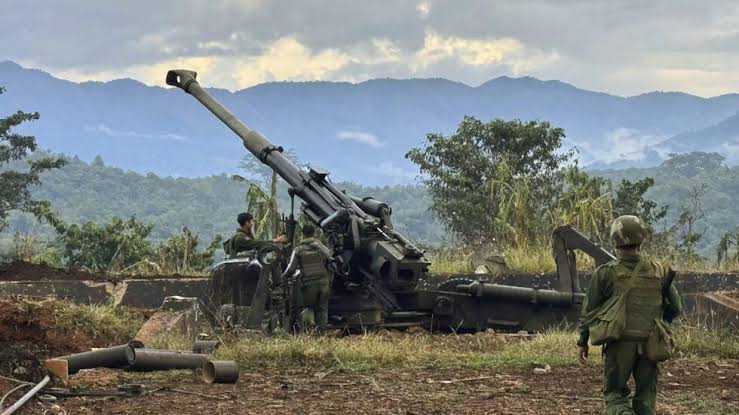Myanmar’s rebel offensive poses challenges for India
In its fight against a number of ethnic rebel outfits, the Myanmarese army has lost huge swathes of territory. And India has much to worry over the latest spurt in fighting.

Myanmar’s oppressive military junta seems to be falling apart exactly three years after the coup that blocked an elected government from taking power. In its fight against a number of ethnic rebel outfits, the Myanmarese army has lost huge swathes of territory. And India has much to worry over the latest spurt in fighting.
For one, the takeover of an estimated 60 percent of Rakhine state and 30 percent of the adjoining Chin state by the Arakan Army threatens the India-financed $484-million Kaladan multi-modal transport (KMMT) project, which aims to connect India’s eastern ports with Sittwe by sea and then on to Mizoram through the Kaladan river.
This was conceived as a key connectivity project to access India’s Northeast at a time when the BNP-Jamaat government in Bangladesh was unwilling to give India the right of passage through its territory. Now, with the Hasina government giving India the use of its ports and roads to access the Northeast, the Kaladan project is at best an alternative route that might be difficult to activate.
India has a history of involvement in the region. When the Arakan Army attacked barges carrying construction material for the KMMT project, India in 2019-20 initiated Operations Sunrise in two phases to deny them bases near the Mizoram-Myanmar border. The Arakanese rebels haven’t also forgotten Operation Leech of 1998, when Indian forces invited leaders of the National Unity Party of Arakan to the Andaman islands and killed seven of them in a controversial move detailed by Nandita Haksar in her book, Rogue Agent: How Indian Military Intelligence Betrayed the Burmese Resistance.
Now India has issued an advisory to its citizens to leave and stay away from Rakhine in view of the Arakan Army’s successful offensive that forced the Tatmadaw, the Myanmar military, to withdraw from large tracts of Rakhine and Chin. The loss of the key road-river junction town of Paletwa, where Myanmarese brigadier Zin Myo Swe was arrested with 300 soldiers and many others were forced to surrender, was a major strategic and psychological blow to the military junta.
Paletwa is key to operationalising the KMMT project. So India either has to open back channels to negotiate with the Arakan Army or try to back the Tatmadaw with active support, in which case Delhi runs the risk of permanently alienating the Rakhines. With this, Delhi is clearly caught between a rock and a hard place, a situation that can be blamed on the long wait-and-watch approach.
Across Myanmar’s border provinces, where a host of ethnic rebel armies have won a string of military victories since the 1027 offensive began in Novemver 2023, the Rakhine scenario has been repeated—Tatmadaw soldiers have surrendered, joined the resistance, or fled into India, Bangladesh and China.
Meanwhile, northern rebel groups like the Myanmar National Democratic Alliance Army and Ta’ang National Liberation Army have even taken control of trade outposts, threatening closure of the thriving Sino-Myanmarese border trade. Though China is the biggest backer of the junta, it wasted no time in brokering a truce between the rebels and the Myanmarese army, because Beijing has influence over both. The contrast to India’s predicament in Rakhine cannot be sharper.
For now, India seems stuck with supporting the junta, though the ground realities have dramatically changed in four months. India did issue a statement in December appealing to the junta to initiate dialogue with the rebel groups and with the national unity government made up of ethnic resistance groups such as the People’s Defence Forces to restore federal democracy. What it failed to do was take a proactive peace mission to Myanmar and leverage India’s access and credibility with all major stakeholders to push through a peace process.
There are grumbles in the Myanmarese army’s upper ranks, too. Pressure is mounting on the junta supremo, General Min Aung Hlaing, to step down and pave the way for reconciliation and return to democracy. Journalists and bloggers have launched unprecedented tirades against the general in the past two weeks as the Tatmadaw lost control of nearly 40 towns.
“Such public utterances against the powerful junta leader would have been unthinkable just a few months ago,” says Gautam Mukhopadhyay, a former Indian ambassador to Myanmar.
Military insiders say senior officers looking to stop the string of defeats are pitching for Soe Win to take over. Former military intelligence chief General Myat Tun Oo and former home minister Soe Htut are leading the anti-Hlaing faction.
“Though I don’t see the military immediately apart, it will find it hard to regain territorial control over some key border provinces,” says Willem Van Schendel , a historian and author of acclaimed works on the region.
This has led to a continuous refugee flow into Mizoram and Manipur, which upsets the local calculations even more than the volatile region can take. India now wants to restrict the free flow of people across the border. This is again a contrast to the China-Myanmar border, which Beijing is still keen to keep open to operationalise its own Yunan- Rakhine corridor plan.
At stake is India’s vaunted Act East policy. The effort to situate the underdeveloped Northeast at the heart of India’s engagement with Southeast Asia, which P V Narasimha Rao had initiated with such single-minded focus, will get nowhere. A stable and peaceful Myanmar with a functioning democracy holds the key to Act East through the Northeast.